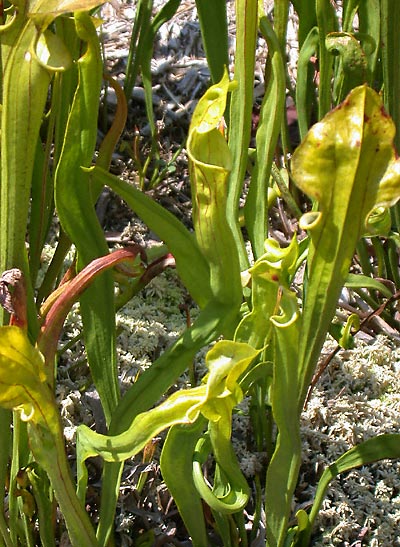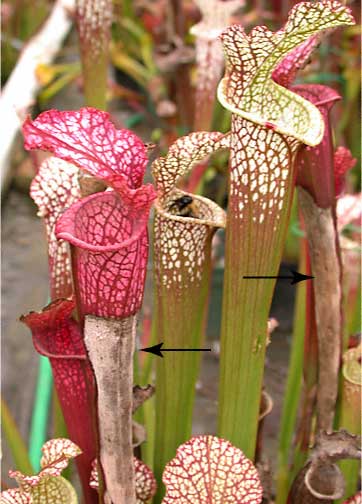|
|
|
|
| Leaf/Pitcher problems and abnormalities. |
Please note this new section is under development! |
|
| Be sure to read the introduction/disclaimer before reading further! |
|
|
|
 |
Thrips are tiny insects in the order Thysanoptera. The plant pests saw/chew and suck plant juices. They are often worse in drought years and attack a huge variety of plants, seeming to prefer tender growth.To the left is a Sarracenia flava damaged by thrips. While seldom lethal, thrips can cause deformed, twisted and curled foliage and flowers. Thrips are very tiny,often less than a millimeter long. Since many can fly and disappear quickly, approach suspect plants slowly and look for moving, long-shaped specks. Magnification is very helpful in identifying thrips. Other groups of insects can also cause damage similar to thrips. These include: aphids on new growth, mealybugs (common or Mexican) on new growth, root mealybugs in the crown , rhizome and roots, or leafhoppers on new growth. Most of these insects can be controlled with Orthene, applied as a heavy spray during the evening. Soil systemic insecticides, such as Marathon can also be effective. I am unaware of any effective organic control. Insecticidal soaps are often toxic or damaging to plants, especially carnivorous plants. |
|
 |
|
|
| The arrows to the left point to damaged zones caused by excessive insect capture. While we casually refer to this as "indigestion" it is most likely a result of nutrient burn coupled with some microbial action. We see this a lot during mid to late summer, when the insect populations are high. Notice the Carpenter bee (a Giant bumble bee) clinbing out of the center pitcher; that's because we plugged the newly opened pitcher with a small crumpled wad of Reemay® fabric. We tear off a piece and plug the mouth of the pitchers, just out of sight, a procedure we call "gagging". This also can help to keep Carpenter Bees from chewing holes in the pitchers. Breathable, non-absorbant material, such as Reemay or nylon stockings can work, but using plastic wrap or non-porous is probably not wise as it may encourage fungal infections. This leaf burn is usually harmless, but some growers may wish to prevent insect capture to use the pitchers as cut flowers or to maximize the display of a garden. Some Sarracenia, such as the dark red S. alata, don't color-up for awhile and may need gagging to achieve best color before excessive insect capture burns off the pitcher.Gagging has not shown to cause harm or reduced growth in our nursery. |
|
 |
This information also appears in the root disease section.
Sclerotinia is a very unwelcome fungus that has several infectious forms in leaves stems and root systems. Often, it begins underground and climbs upward, as shown to the left. Pictured is an infected Calopogon colony. The globular sclerotium are dormant reproductive structutures which can stay viable for years. Their appearance gives rise to one common name: "Mustard Seed Fungus". These sclerotia grow in favorable conditions and spread spores which spread the infections. Flytraps (Dionaea) are vulnerable, as are many thousands of other plants. In Dionaea, the crown seems to melt prior to sclerotia appearing. Remove infected plants and soil; do not compost this or re-use the infected soil unless autoclaved or steam sterilized. Remove healthy plants that are nearby (within about a foot) and that soil as well. Apparently healthy plants may be washed thoroughly to remove any soil/media and possible contaminants. Use fresh soil to replant. Systemic fungicides can help a great deal. Cleary's 3336 and Zyban have shown good control of Sclerotinia.
|
|
| Floppy, spindly leaves or pitchers are usually a sign that the plant is not getting enough light. One clue is to see if the plant is showing normal coloration. If there is an absence of red pigment (in plants that should have some) then light starvation is a good guess. Sometimes, plants can make seasonal growth that is normally thinner; the spring growth of flytraps and the White-topped Pitcher Plant (Sarracenia leucophylla) can be quite thin, as can the fall pitchers of the Yellow Pitcher Plant (S.flava). Sarracenia often make flat leaves, phyllodia, which appear during certain seasons. This may be an adaptation to dry seasons or cold weather. Sarracenia flava often makes late-season phyllodia. Sarracenia leucophylla often makes phyllodia in mid-summer.
Sundews typically show a lack of pigment or bizarre leaf shapes if grown under too little lighting.Heliamphora tend to make abnormal nectar spoons if grown under low light or higher temperatures. If you suspect lighting is causing poor appearance or growth, increase the light intensity gradually over the course of weeks, a little more every few days. While most plants can survive a sudden increase in light, it can burn foliage that is used to lower light.
|
|
| We will add to this section as time/energy permit. |
|
|
|
| Go to: Home/index, disease introduction page, Sarracenia, Nepenthes, Heliamphora, Sundews, Venus's Flytrap, Botanical Gems |
|
|
|
|
|
|
|
|
|
|
|


